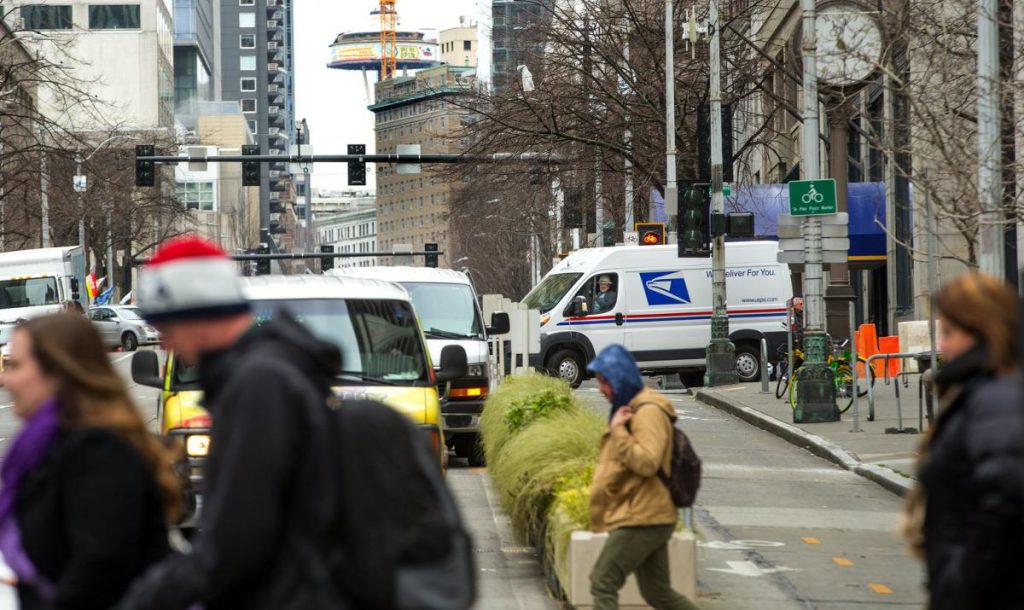
By Michelle Baruchman, Seattle Times staff reporter
A University of Washington and Seattle Department of Transportation study found the explosion of e-commerce and urban growth has dramatically added to the number of vehicles circling the Center City.
Warm deli sandwiches and fresh salads moved from a prep kitchen to a truck to Millennium Tower, through building security and up to an office suite just in time for lunch on Tuesday.
The delivery was part of an ever-growing explosion of e-commerce that has dramatically added to the number of vehicles circling Seattle’s Center City each day.
That congestion is compounded by the fact that just 13 percent of buildings in downtown, uptown and South Lake Union have private loading bays or docks, forcing delivery trucks to use the city’s curb and alley spaces to make deliveries, according to a study released Thursday.
And it puts delivery companies in the position of choosing between their customers and following the law.
According to the joint study between the University of Washington’s Supply Chain Transportation & Logistics Center and the Seattle Department of Transportation, the number of truck trips in that urban core may double by 2023. That’s if no more residents move in and the mode of delivery stays consistent, said Barbara Ivanov, chief operating officer of the Supply Chain Transportation & Logistics Center who worked on the study.
In 2016, 8 percent of all U.S. retail sales took place online. Since 2010, growth in national online sales has increased by a 15 percent average annual rate.
“I don’t think the developers really thought about how fast Amazon was going to blow up when they built our tower,” said Jeff Maxwell, a concierge at Insignia Towers, a 1,500-person residential complex researchers examined.
The $205,000 study, part of a three-year contract between SDOT and UW’s Urban Freight Lab, analyzed the street network and the city’s vertical spaces, such as office, hotel, retail and residential towers, as one unified goods-delivery system.
Out of the data, researchers set two priorities: reduce the number of “failed first delivery attempts,” in which for a variety of reasons a package or parcel does not reach a consumer on the first try, and reduce the time trucks are parked in load spaces.
For many deliveries, the most difficult part is from the truck to the suite door inside the office building — which local researchers refer to as the final 50 feet.
Between finding curb space, clearing security, riding the freight elevator and locating a tenant door, deliverers hold packages and parcels for an increasingly extended period of time.
Tom O’Connor, owner of Market Fresh Fruit – Eat Healthy At Work, said he incurred $500 in tickets in the past year from illegal parking.
“With so many successful companies coming into Seattle and tenants filling buildings, a lot more businesses are going in,” he said. “I don’t think the city has adjusted, and I’m left to my own devices to get food to customers.”
Staysha Palm, a deliverer for FedEx, said she often competes for curb space with other deliverers as well as Uber and Lyft drivers.
“If the load zones are filled with parked cars or people waiting for riders, I have to circle around two or three times,” she said. “Within those two minutes that I circle the block, I could have had my cart set up and delivered a couple more packages.”
Her other main barrier to efficiency is security.
Researchers found clearing security accounted for 12 percent of total delivery time. Riding the freight elevator and looking for tenants’ locations took 61 percent of the total time.
“Sometimes things get lost because there’s a lot of steps and people involved,” said Evan Cole, assistant property manager at Dexter Horton.
As a potential solution, researchers proposed a smart-locker system.
“They pull in, they load the locker or hand everything to a concierge or mailroom, and it cuts all of that transaction time out,” Ivanov said.
They estimated that a secure structure placed in the loading-bay level of the Seattle Municipal Tower would reduce the time delivery people spend in the building by up to 73 percent and will be testing this theory in the next month.
In addition to the study, researchers will be building an online tool kit of practices for other cities to use and replicate.
“It’s not only important to Seattle but other cities struggling with the same problems,” she said.